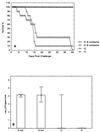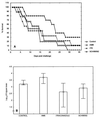SCH 56592, amphotericin B, or itraconazole therapy of experimental murine cerebral phaeohyphomycosis due to Ramichloridium obovoideum ("Ramichloridium mackenziei")
- PMID: 10770745
- PMCID: PMC89838
- DOI: 10.1128/AAC.44.5.1159-1162.2000
SCH 56592, amphotericin B, or itraconazole therapy of experimental murine cerebral phaeohyphomycosis due to Ramichloridium obovoideum ("Ramichloridium mackenziei")
Abstract
Ramichloridium obovoideum ("Ramichloridium makenziei") is a rare cause of lethal cerebral phaeohyphomycosis. It has been, so far, geographically restricted to the Middle East. BALB/c mice were inoculated with two strains of R. obovoideum intracranially. Therapy with amphotericin B, itraconazole, or the investigational triazole SCH 56592 was conducted for 10 days. Half the mice were monitored for survival and half were killed for determination of the fungal load in brain tissue. Recipients of SCH 56592 had significantly prolonged survival and lower brain fungal burden, and this result was found for mice infected with both of the fungal strains tested. Itraconazole reduced the brain fungal load in mice infected with one strain but not the other, while amphotericin B had no effect on brain fungal concentrations. This study indicates a possible role of SCH 56592 in the treatment of the serious cerebral phaeohyphomycosis due to R. obovoideum.
Figures



References
-
- Adam R D, Paquin M L, Petersen E A, Saubolle M A, Rinaldi M G, Corcoran J G, Galgiani J N, Sobonya R E. Phaeohyphomycosis caused by the fungal genera Bipolaris and Exserohilum. A report of 9 cases and review of the literature. Medicine. 1986;65:203–217. - PubMed
-
- Campbell C L, Al-Hedaithy S S. Phacohyphomycosis of the brain caused by Ramichloridiwn mackenziei sp. nov. in Middle Eastern countries. J Med Vet Mycol. 1993;31:325–332.
-
- Dixon D M, Walsh T J, Merz W G, McGinnis M R. Infections due to Xylohypha bantiana (Cladosporium trichoides) Rev Infect Dis. 1989;11:515–525. - PubMed
-
- Matsumoto T, Matsuda T, McGinnis M R, Ajello L. Clinical and mycological spectra of Wangiella dermatitidis infections. Mycoses. 1993;36:145–155. - PubMed
MeSH terms
Substances
LinkOut - more resources
Full Text Sources
Medical
Miscellaneous

